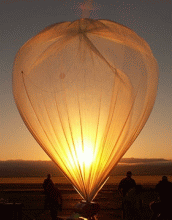News Release 06-126
High-Flying Balloons Track Hurricane Formation
Devices will float over Atlantic Ocean hurricane "seedling" areas
August 31, 2006
This material is available primarily for archival purposes. Telephone numbers or other contact information may be out of date; please see current contact information at media contacts.
The eastern tropical Atlantic Ocean is out of range for U.S. hurricane-hunter aircraft, and forecasters have little skill predicting which systems brewing there will develop into hurricanes, atmospheric scientists say. So, to find out how some of the most dangerous hurricanes form, U.S. and French researchers are launching large, specialized balloons carrying nearly 300 instruments over wide swaths of Africa and the Atlantic Ocean.The first launch of a balloon with its instruments, called a driftsonde, took place at Zinder, Niger, on Aug. 28. Some seven more driftsondes will be released from Zinder through late September, coinciding with the peak period of hurricane formation over the tropical Atlantic.
"Data from the driftsondes should help characterize the conditions that either foster or suppress hurricane formation," said the National Science Foundation's (NSF) Cliff Jacobs, who oversees support for the National Center for Atmospheric Research (NCAR) in Boulder, Colo.
Scientists and engineers at NCAR and the French space agency, CNES, developed the driftsondes. The research was funded by NSF, NCAR's primary sponsor, and the National Oceanic and Atmospheric Administration.
Each balloon will drift from Africa toward the Caribbean at heights of around 65,000-70,000 feet, where light easterly winds prevail. Twice a day, each balloon will release an instrument known as a dropsonde that falls by parachute, sensing the weather conditions during its 20-minute descent and sending data back to the balloon and then to the researchers by satellite.
Scientists will control the process from an operations center in Paris. If a weather system develops, they can signal the balloon to release additional dropsondes as often as once per hour.
The Niger site was selected to study weak weather systems, called easterly waves, that serve as seedlings of hurricanes. Dozens of these waves move across Africa into the Atlantic between about 10 and 20 degrees North. A small number develop into tropical storms and hurricanes, some of which reach the U.S. Atlantic and Gulf coasts.
"The driftsondes will provide unique data on the conditions that lead to Atlantic hurricanes," said NCAR scientist David Parsons, U.S. coordinator for the project. "They float at a speed close to the movement of the easterly waves, so we can stay above those waves and monitor them from their earliest stages."
To build the driftsonde system, scientists, engineers, and machinists had to overcome many hurdles. Each driftsonde had to be robust enough to endure days of extreme stratospheric cold (averaging minus-80 degrees Fahrenheit) as well as the intense sunlight of the high, thin atmosphere.
For the balloon deployment to be affordable and practical, the system also required low-cost, lightweight, off-the-shelf instruments capable of operating reliably in low pressure and in temperature extremes with very low power.
Because of their flexible and relatively inexpensive nature, scientists believe, driftsondes may soon become a popular way to monitor and study many types of weather across the world's oceans and other remote regions.
-NSF-
Media Contacts
Cheryl Dybas, NSF, (703) 292-7734, email: cdybas@nsf.gov
David Hosansky, NCAR, (303) 497-8611, email: hosansky@ucar.edu
The U.S. National Science Foundation propels the nation forward by advancing fundamental research in all fields of science and engineering. NSF supports research and people by providing facilities, instruments and funding to support their ingenuity and sustain the U.S. as a global leader in research and innovation. With a fiscal year 2023 budget of $9.5 billion, NSF funds reach all 50 states through grants to nearly 2,000 colleges, universities and institutions. Each year, NSF receives more than 40,000 competitive proposals and makes about 11,000 new awards. Those awards include support for cooperative research with industry, Arctic and Antarctic research and operations, and U.S. participation in international scientific efforts.
Connect with us online
NSF website: nsf.gov
NSF News: nsf.gov/news
For News Media: nsf.gov/news/newsroom
Statistics: nsf.gov/statistics/
Awards database: nsf.gov/awardsearch/
Follow us on social
Twitter: twitter.com/NSF
Facebook: facebook.com/US.NSF
Instagram: instagram.com/nsfgov



